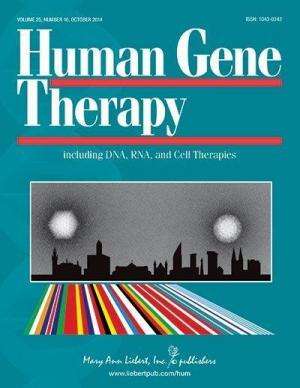Credit: Mary Ann Liebert, Inc., publishers
Excessive and often lethal blood levels of bilirubin can result from mutations in a single gene that are the cause of the metabolic disease known as Crigler-Najjar syndrome type 1 (CNS1). A new gene therapy approach to correcting this metabolic error achieved significant, long-lasting reductions in bilirubin levels in a mouse model of CNS1 and is described in an Open Access article in Human Gene Therapy.
In "Life-Long Correction of Hyperbilirubinemia with a Neonatal Liver-Specific AAV-Mediated Gene Transfer in a Lethal Mouse Model of Crigler–Najjar Syndrome," Giulia Bortolussi and coauthors from the International Centre for Genetic Engineering and Biotechnology; Centro Studi Fegato, Fondazione Italiana Fegato; and University of Trieste (Trieste, Italy) and Charles University (Prague, Czech Republic), present details of the adeno-associated virus (AAV)-mediated gene therapy approach they used to correct the metabolic disorder that causes hyperbilirubinemia in CNS1. The researchers reported 70-80% reductions in plasma bilirubin levels early on among treated animals, with about 50% reductions maintained throughout the study. The authors compared the effectiveness of two delivery strategies: targeting the therapeutic gene directly to the liver or, preferably, to skeletal muscle. They discuss the implications of the different results they obtained with each approach.
"CNS1 is an outstanding model for in vivo gene therapy with easily measured and clinically relevant metabolic endpoints," says James M. Wilson, MD, PhD, Editor-in-Chief of Human Gene Therapy, and Director of the Gene Therapy Program, Department of Pathology and Laboratory Medicine, University of Pennsylvania Perelman School of Medicine, Philadelphia.
More information: The article is available on the Human Gene Therapy website at http://online.liebertpub.com/doi/full/10.1089/hum.2013.233.
Journal information: Human Gene Therapy
Provided by Mary Ann Liebert, Inc






















